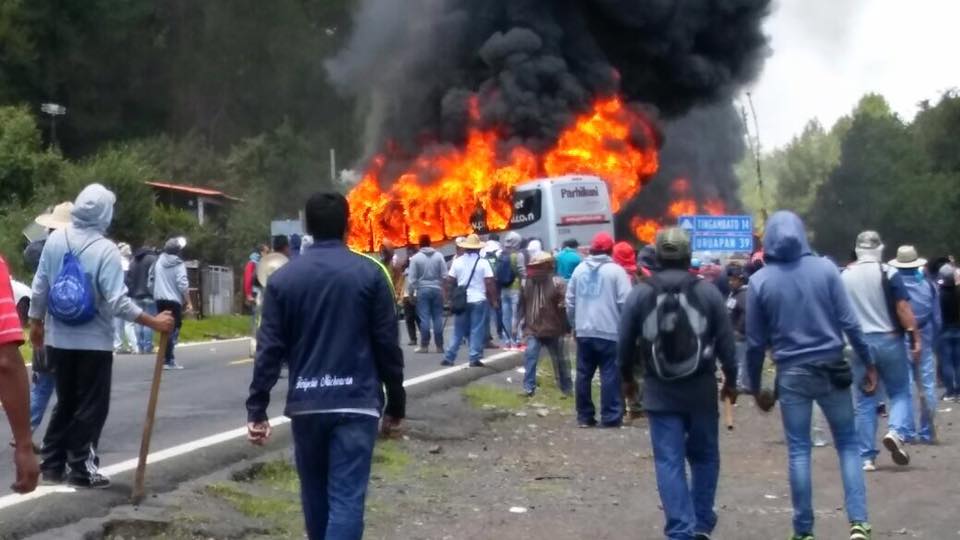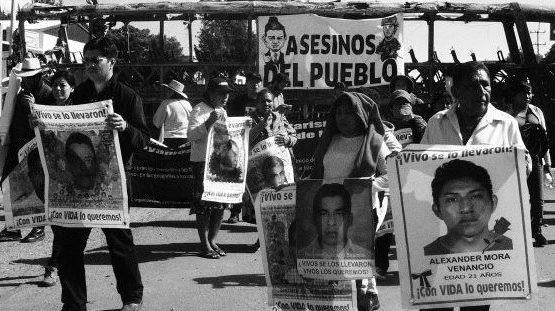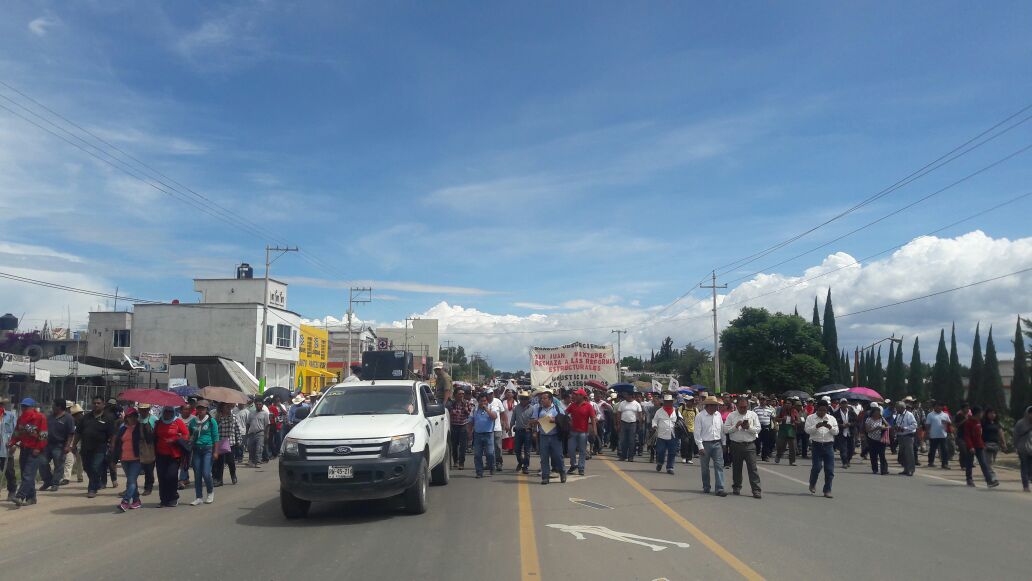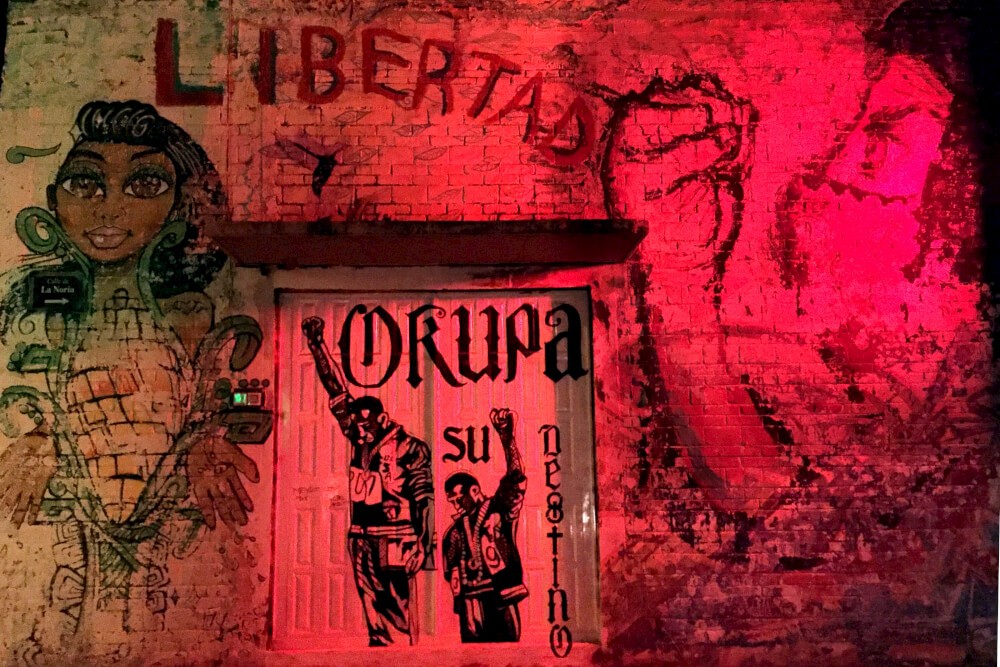Filed under: Editorials, Indigenous, Insumisión, Labor, Mexico, Southern Mexico

Originally published by It’s Going Down
By Scott Campbell
With the ongoing teachers’ strike that has morphed into a widespread rebellion, primarily in Oaxaca and Chiapas, we haven’t put together a more general roundup of resistance and repression in Mexico in some time. While that struggle is very much alive and well, the intensity with which it is unfolding has diminished some. This column will first take a look at the past three weeks of that conflict (if you need to get up to speed, check out this piece) and then cover some of the other recent events around the country.

The teachers belonging to the National Coordinator of Education Workers (CNTE) have now been on strike for more than two months. Since the massacre by federal and state forces in Nochixtlán, Oaxaca on June 19, in which eleven people were killed, the conflict has taken on an increasingly popular dimension. This has looked like direct actions, marches, material support and expressions of solidarity from across Mexico and beyond, in numbers far too large to recount individually.
By way of example, here are some of the actions that have occurred over the past few weeks. Parents and teachers took over toll booths in both Mexico City and Durango for a day, allowing cars to pass through for free. On July 3, an explosives device was detonated at the headquarters of business associations in Mexico City who have been lobbying the government to crush the uprising. There were three days of intense mobilizations from July 5-7 in Mexico City. On the first day, there were at least 70 simultaneous blockades and marches, followed by four mass marches on July 6, and at least ten blockades on July 7.

Parents of the disappeared students from Ayotzinapa make a solidarity visit to Nochixtlán.
The Zapatistas have continued releasing statements in support of the teachers’ struggle, stating, “To say it more clearly: for us Zapatistas, the most important thing on this calendar and in the very limited geography from which we resist and struggle, is the struggle of the democratic teachers’ union.” They also went further and announced that they were suspending their participation in the July 17-23 CompArte Festival for Humanity, which they had called for earlier this year. Instead, they sent delegations from all the Zapatista caracoles to donate the food they would have eaten during the seven day festival to the teachers in resistance in Chiapas. This amounted to 290,000 pesos (15,600 USD) worth of food.
In recognition of the contribution of the people to their struggle and the fact that the people have demands which extend beyond the immediate concerns of the union, on July 9, Section 22 of the CNTE in Oaxaca called for a gathering of teachers and indigenous leaders to “build a peoples’ agenda against structural reforms.” The union met with authorities from 90 municipalities in the state. Important to note is that these authorities are selected as the moral leadership of their communities not through a vote based on political party, but through nominations, discussions and agreements reached in community assemblies. The first outcome of that gathering was the Indigenous Peoples Caravan, which traveled from Oaxaca to Mexico City from July 17-19, with the participation of more than 120 municipal authorities and the teachers union. The union is making a similar effort in Chiapas, where they announced union delegates will visit every community in the state to meet with parents and members of civil society. Also in Chiapas, 52 church parishes, primarily adherents to liberation theology, marched in support of the teachers on July 19.
Along with Oaxaca, Chiapas and Mexico City, Michoacán has been holding it down. On July 11, teachers blockaded train tracks at seven different points throughout the state. (Michoacán is home to Lázaro Cardenas, Mexico’s biggest port and one of the largest seaports along the Pacific.) A week later, on July 19 and 20, state and federal forces attacked teachers’ highway blockades there, with 25 teachers being arrested on July 20. More by coincidence than coordination, an attack also occurred on the highway blockade outside of San Cristóbal de las Casas, Chiapas on July 20. In that incident, state and municipal police loaded armed and masked members of the Green Party (PVEM – a right-wing party distinct from international Green Parties) from San Juan Chamula into a tractor trailer, drove it to the blockade and opened it up, providing cover while the paramilitaries attacked and burned the blockade and encampment. Fortunately there were no deaths, though one teacher was shot in the shoulder by a paramilitary. In response, teachers and supporters regrouped in the city center of San Cristóbal, taking over the old city hall and flying a red and black flag from it. (Along with the anarchist connotations, a red and black flag flying from a building in Mexico typically signals that the workers in that building are on strike.) They then marched back to the site of the blockade and built it up once again, where it remains. More context on San Juan Chamula to come later in this piece.

Indigenous Peoples Caravan passing through Nochixtlán.
At the same time that all these actions have been occurring, the CNTE and the Interior Ministry have been holding negotiations. They have met a total of six times, addressing political, educational and social issues. At each meeting the teachers come prepared with specific proposals and ask the government to do the same. After each meeting the end result has been the same: no progress. They will meet again on July 26.
In an attempt to subvert the mobilization of the CNTE, the Public Education Ministry has begun negotiations with the National Union of Education Workers (SNTE), the union that all teachers in Mexico belong to and of which the CNTE is considered a “dissident faction.” While telling the CNTE that the educational reform is non-negotiable, the government has indicated to the SNTE that is it willing to modify it. The CNTE responded to this by referring, in an official statement, to the SNTE leadership as “the system’s rats” who “are being increasingly exposed as true mercenaries and scabs.”
The last bit of news from the electoral realm is that on July 14, Andrés Manuel López Obrador (AMLO) – who for Mexican politics is something like a never-ending Bernie Sanders – proclaimed, “You can’t repeal the educational reform; that would be a failure of government and doesn’t serve anybody. There must be authority.” AMLO’s latest party, MORENA (he used to be PRI, then PRD), has tried to capitalize on the teachers’ strike to grow their numbers yet its partisans have been notably silent regarding their leader’s rejection of the main demand of the strike.
In some sad news, a teacher, José Caballero Julián, who was wounded on June 11 when state forces attacked the teachers’ encampment in front of the Oaxaca State Institute of Public Education (IEEPO), died of his injuries on July 5. In addition to the eleven massacred in Nochixtlán, Azarel Galán Mendoza who was killed in Viguera and Salvador Olmos García, the anarchist and journalist murdered by police in Huajuapan, Caballero’s death brings the total to fourteen killed by the state in Oaxaca during the course of the rebellion so far.
While the growing national mobilizations initiated by the teachers’ strike has dominated headlines and coverage from Mexico, there are of course numerous ongoing resistances that at least on the surface can be seen as independent of that struggle. The matter pending before the union and the people in resistance is if and how these fights, most of which are directed against neoliberal capitalism and the state, can be coherently integrated into a broader movement. As mentioned above, steps have been taken in that direction, but for the most part it is still the teachers union at the wheel.

“Occupy your destiny.” Recent street art in Oaxaca.
Students from the Xochimilco, Azcapotzalco and Iztapalapa campuses of the Autonomous Metropolitan University (UAM) in Mexico City won a major victory earlier this month after occupying the university President’s Offices. The takeover was in response to cuts in scholarships for studying aboard or elsewhere in Mexico. After holding the building and following a twelve hour meeting with the administration, they left with the university agreeing to fund 100 percent of scholarships. Also in Mexico City, riot police attacked a gathering of indigenous peoples at the Monument to the Revolution on July 15. The organizations and communities were protesting their exclusion and the exclusion of indigenous practices from the process Mexico City is currently going through to restructure its form of governance.
The violence continues unabated in Veracruz, where on July 7, Jairo Guarneros of the Colectivo Feminista Cihuatlahtolli in Orizaba, survived an assassination attempt that occurred one day after he denounced the police murder of a woman riding in a taxi. After killing the woman, the police fled the scene. Pedro Tamayo Rosas became the 17th journalist murdered in Veracruz during the reign of Governor Javier Duarte. Shot eleven times at his home on July 20, Tamayo lived in and reported on the Tierra Blanca region. He had previously fled the state following threats he received for his coverage of the disappearance of five young people by police in that region in January.
With his legacy of oppression, violence and exploitation, Mexican President Enrique Peña Nieto certainly has a lot to make amends for. So what did he actually decide to apologize for? On July 18, he asked forgiveness for the “perception” of wrongdoing that occurred when in 2014 his wife purchased a $7 million mansion – known as the White House – in Guerrero from a corporation that had tens of millions of dollars’ worth of government contracts. Two days later, the well-known journalist who broke the story, Carmen Aristegui, was sued by her former employer, MVS Radio, to stop the publication of a book on the Casa Blanca scandal. MVS fired Aristegui in 2015 after she first reported on the story. Naturally, MVS and the federal government deny any collusion.
In Cuidad Ixtepec in Oaxaca, organizing continues against attempts by the Canadian mining company Linear Gold Corporation to mine in the area, a project that would not only damage the environment but also archeological sites. On July 12, indigenous women from Ixtepec destroyed a concrete topographical marker put in by the company, followed by a 500-person protest a week later.
This weekend, Oaxaca is seeing three days of festivities for the Tenth Annual Teachers-Peoples Guelaguetza. Guelaguetza is both an indigenous concept and celebration premised on mutual aid and community participation, where communities from around the state come to the city of Oaxaca and hold marches, banquets and dances conveying the traditions of each community. The biggest festival of the year, the Guelaguetza became commercialized by the state, with tickets to attend costing $40, well beyond the reach of the average Oaxacan. Following the 2006 uprising, the Popular Assembly of the Peoples of Oaxaca (APPO) announced a boycott of the official Guelaguetza and ever since the teachers union and civil society groups have been organizing their own free version. Here’s the promo trailer for this year:
As was mentioned above, the Zapatistas stated they were suspending their participation in the CompArte (a spin on the words “art” and “sharing”) Festival for Humanity. In one statement, they offer a breakdown of the original plans for the 1,400-plus artists who were going to participate (along with a video of Zapatistas dancing to Ska-P). In response, CIDECI-Unitierra, who often assists in the organization of Zapatista events in San Cristóbal, announced they’d still be holding an abridged version of the festival. In response to that response, the Zapatistas backed off their decision to not participate at all and invited everyone to come to Oventik on July 29 to participate in a condensed presentation of what they had prepared for the festival.
The last piece of news from Chiapas brings us back to San Juan Chamula, some of whose residents attacked the teachers’ blockade on July 20. Following that incident, several communities in the municipality of Chamula released a statement condemning the attack, expressing their support for the teachers, and threatening, “The municipality of Chamula will rise up in arms if necessary. If the government doesn’t want peace, then we won’t give them peace.” The Zapatistas also presciently stated, “And some unsolicited advice: don’t play with fire in Chamula. The unrest and division you are inciting in that town with your stupidities could provoke an internal conflict of such terror and destruction that you wouldn’t be able to quash it with social network bots or paid ‘news’ articles or the little money that Manuel Joffrey Velasco Baratheon-Lannister has left in the state treasury.”
And then three days later it happened. On July 23, a group of individuals affiliated with the PRI showed up at the town hall demanding that the mayor – affiliated with the PVEM – pay them the money he owed them for their artisanal work. He refused to do so at that moment and the PRIistas stormed the building. The mayor and his bodyguards opened fire and an hours-long shootout commenced in the center of the town. In the end, five people were killed, including the mayor.
San Juan Chamula is a popular tourist destination due to its religious festivities and proximity to San Cristóbal. It is also a deeply divided Tzotzil municipality. This began decades ago following the conversion of growing numbers of Chamulans to evangelical Christianity by outside missionaries. They clashed with those who remained adherents to the indigenous-Catholic tradition that emerged following colonization, using the pretext of religion to settle disputes over land and territory, leaving dozens dead. Political parties – primarily the PRI and PVEM – have supported or attacked these factions depending on the needs of power, leading to events like the ones seen on July 20 and 23. Another conflict between the PRI and PVEM caused the deaths of two people and the displacement of 81 in Chenalhó, Chiapas on May 26. Manipulation of internal divisions by political parties within a context of neoliberal exploitation is one of the main factors pushing many indigenous communities to organize for autonomy, to ban political parties and to return to making decisions using community assemblies according to practices generically referred to as usos y costumbres.
In our last bit of news, some anarchists in Tijuana published a roundup of some of their activities in recent months, including sabotage attacks and banner drops – some in solidarity with anti-police and anti-fascist mobilizing in the US and anarchist political prisoners worldwide.






